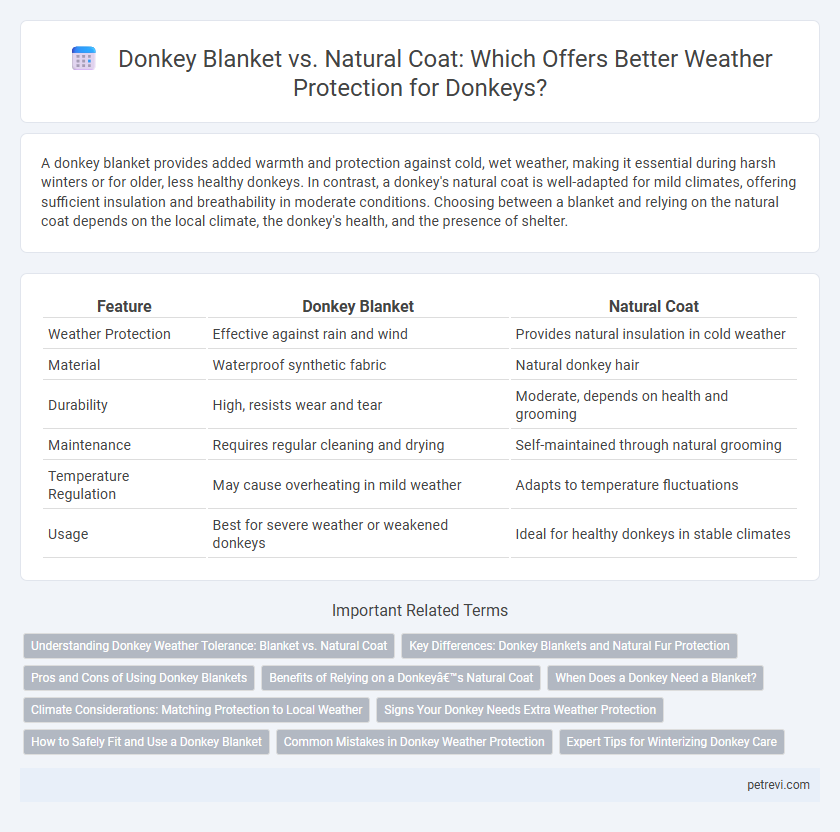A donkey blanket provides added warmth and protection against cold, wet weather, making it essential during harsh winters or for older, less healthy donkeys. In contrast, a donkey's natural coat is well-adapted for mild climates, offering sufficient insulation and breathability in moderate conditions. Choosing between a blanket and relying on the natural coat depends on the local climate, the donkey's health, and the presence of shelter.
Table of Comparison
| Feature | Donkey Blanket | Natural Coat |
|---|---|---|
| Weather Protection | Effective against rain and wind | Provides natural insulation in cold weather |
| Material | Waterproof synthetic fabric | Natural donkey hair |
| Durability | High, resists wear and tear | Moderate, depends on health and grooming |
| Maintenance | Requires regular cleaning and drying | Self-maintained through natural grooming |
| Temperature Regulation | May cause overheating in mild weather | Adapts to temperature fluctuations |
| Usage | Best for severe weather or weakened donkeys | Ideal for healthy donkeys in stable climates |
Understanding Donkey Weather Tolerance: Blanket vs. Natural Coat
Donkeys possess a natural coat that provides effective insulation against moderate weather changes but may struggle in extreme cold or wet conditions, necessitating additional protection. A donkey blanket offers enhanced defense against harsh elements such as heavy rain, wind, and freezing temperatures by providing an extra layer of warmth and water resistance. Assessing the climate and individual donkey health is crucial for deciding between relying solely on their natural coat or supplementing with a weather-resistant blanket.
Key Differences: Donkey Blankets and Natural Fur Protection
Donkey blankets provide consistent insulation and waterproof protection, especially useful during harsh weather or when donkeys have been clipped, whereas the natural coat offers seasonal adaptability and self-regulating temperature control through its dense, water-resistant fur. Blankets can prevent prolonged exposure to cold and moisture, reducing the risk of illness, while natural fur relies on shedding and growth cycles to adjust insulation according to environmental changes. Choosing between a blanket or natural coat depends on climate severity, donkey health, and management needs to optimize weather protection effectively.
Pros and Cons of Using Donkey Blankets
Donkey blankets provide essential insulation and protection against harsh weather conditions, preventing chilling and promoting overall health, especially during cold, wet winters. However, their use can sometimes lead to overheating or skin irritation if not properly fitted or monitored, which may disrupt the donkey's natural thermoregulation. While blankets offer a controllable barrier against cold, they require regular maintenance and assessment to avoid issues such as dampness buildup or restricted movement.
Benefits of Relying on a Donkey’s Natural Coat
A donkey's natural coat provides optimal insulation and breathability, adapting to temperature fluctuations and preventing overheating or chilling without additional layers. This natural barrier also repels dirt and moisture, reducing the risk of skin infections and maintaining overall health. Relying on their inherent coat minimizes the need for blankets, lowering maintenance and ensuring the animal's comfort in varying weather conditions.
When Does a Donkey Need a Blanket?
Donkeys need a blanket primarily during cold, wet, or windy weather conditions when their natural coat cannot provide sufficient insulation or protection, especially in climates with temperatures consistently below 5degC (41degF). Young, elderly, or sick donkeys, as well as those clipped or with thin coats, are more susceptible to hypothermia and benefit the most from additional covering. Regularly assessing the donkey's body condition, behavior, and coat quality helps determine when a blanket is necessary to maintain optimal health and comfort.
Climate Considerations: Matching Protection to Local Weather
Donkey blankets provide essential insulation in cold, wet climates, preventing hypothermia and protecting against harsh wind and rain, while natural coats excel in moderate or dry environments by allowing breathability and natural temperature regulation. In regions with fluctuating temperatures or frequent moisture, combining a lightweight, breathable blanket with the donkey's natural coat ensures optimal comfort and health. Selecting weather-appropriate protection leverages the animal's natural defenses while addressing specific climate challenges, reducing the risk of illness and stress.
Signs Your Donkey Needs Extra Weather Protection
A donkey may need extra weather protection if you notice signs such as a dull or patchy coat, shivering during cold weather, or difficulty maintaining body weight. Changes in behavior like increased lethargy or seeking shelter more frequently also indicate potential discomfort from harsh weather conditions. Observing these signs early helps determine whether a donkey blanket is necessary to supplement their natural coat.
How to Safely Fit and Use a Donkey Blanket
Properly fitting a donkey blanket involves measuring the donkey's length from chest to tail and choosing a size that allows comfortable movement without slipping. Secure the blanket with adjustable straps around the chest and belly, ensuring they are snug but not overly tight to prevent chafing or restricted circulation. Regularly check the donkey's skin for irritation, adjust the blanket fit as needed, and remove the blanket during warm weather to avoid overheating.
Common Mistakes in Donkey Weather Protection
Common mistakes in donkey weather protection include relying solely on blankets without considering the donkey's natural coat, which provides essential insulation and water resistance. Over-blanketing can lead to overheating or skin irritation, while neglecting proper grooming reduces the coat's effectiveness against cold and moisture. Understanding the balance between using a donkey blanket and maintaining a healthy natural coat is crucial for optimal weather protection and animal welfare.
Expert Tips for Winterizing Donkey Care
Effective winterizing for donkeys involves selecting the right protection, where a donkey blanket offers insulated warmth and shields against wind and moisture, crucial in harsh winter climates. Experts advise prioritizing natural coat maintenance through proper nutrition and grooming to enhance the donkey's natural insulation capabilities. Combining natural coat care with high-quality, breathable donkey blankets optimizes weather protection, preventing hypothermia and skin issues during cold and wet seasons.
Donkey Blanket vs Natural Coat for Donkey Weather Protection Infographic

 petrevi.com
petrevi.com